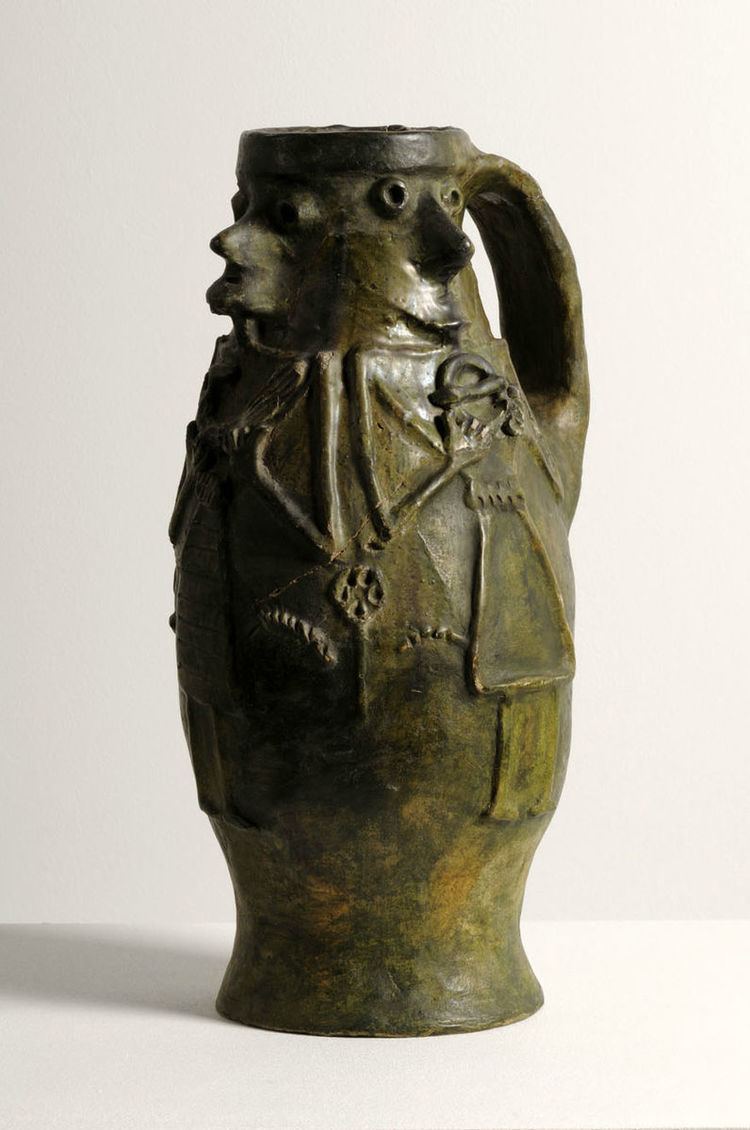 | ||
A face jug is a jug pottery that depicts a face. Early examples date from the 14th century. Some of the best known vessels come from North Carolina, South Carolina and Georgia, made by African-American slaves in the mid-1800s. Though the jugs' exact purposes are unknown, many scholars believe they have either practical or spiritual value. Other names associated with African-American face jugs are grotesque jars, monkey jars, or face jars. Modern interpretations started appearing in the same regions during the 1940s.
Contents
The Coventry Herbert Art Gallery and Museum exhibits a rare medieval face jug unearthed beside the site of the local Benedictine priory.
Early forms
England
During the 13th century, craftsmen outside of London became more decorative in their style, creating more anthropomorphic vessels that would characterize Medieval face jugs. In the 1600s full body vessels supposedly modeled after Edward Vernon also known as Admiral Vernon. These pieces came to be known as British Toby Jars.
Africa
African Nkisi dolls, native to the Congo, were considered both object and human. These dolls were made with many different materials including clay. They came to America transported through slave trade, and are found more commonly in Latin American regions. The vessels are full figured pieces characterized by the same exaggerated human features often seen on African-American face jugs. Many rituals associated with Nkisi dolls are used either to aid or to harm a person or other living creature that the dolls play a stand-in role for, or as an extension of a spiritual leader, or as a being that stores spiritual energy.
Speculated uses
Face jugs were fully functional pieces that served the practical purpose of holding and pouring liquid. Various slave owner accounts hold that African-American slaves would use their face jugs to carry water into the fields with them. Other scholars believe that face jugs were used as a form of self-identification, or a Self-Portrait and perhaps were a way for slaves to deal with their physical displacement and loss of visual worth. Some folklore accounts held that these jugs were used for spiritual, rather than practical, purposes. It is believed that the jugs were buried outside of front and back doors to scare spirits away. It is also claimed that these jugs were used as grave markers and placed atop burial sites surrounded with the possessions of the deceased.
Artistic value
As Folk art, face jugs have become a significant feature in the history of African-American art. Because formal ceramic skills to create face jugs were taught after America gained its independence, they are regarded as some of the first truly American pieces. Because of their interesting physical characteristics and historical context behind them, face jugs are important examples of African-American art and as the start of a theme of self-identification that would carry into the future. Some use these vessels may have been as political symbols. Most famously, it is believed that Dave the Potter, a slave who worked in the Miles mill where face jugs were made, was himself protesting against his status through ceramic pieces.
Exhibits
List of American makers of face jugs
American art potters who create face jugs include:
